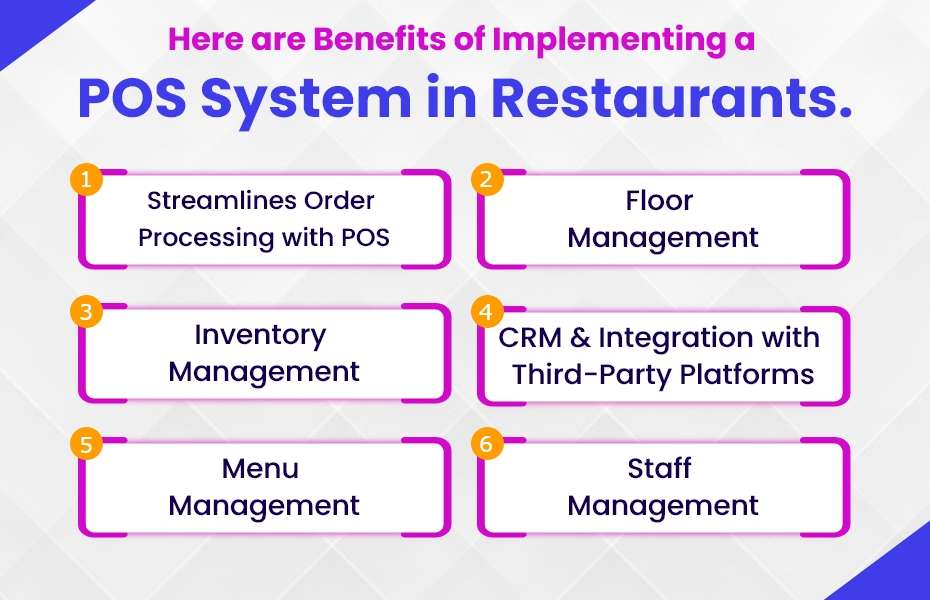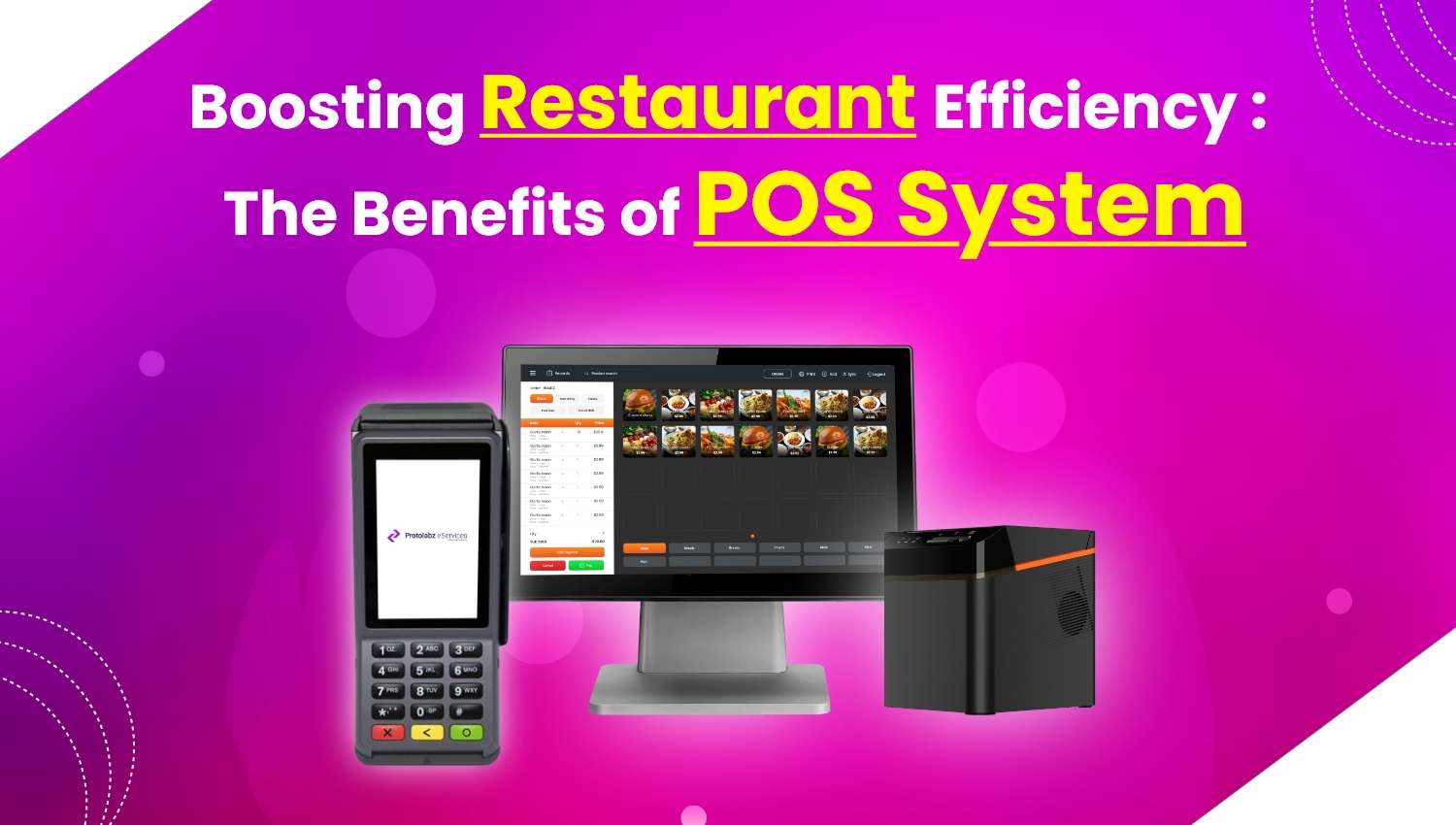In the fast-paced world of restaurant management, efficiency and customer satisfaction are of topmost importance. Point of Sale (POS) is a technological innovation that has revolutionised the restaurant Industry. POS system streamlines the process of taking orders, processing payments, and managing various aspects of restaurant operations. A POS system is an electronic device with a combination of hardware and software for executing transactions at the point of sale.
A POS system can help the cashier to input the customer’s order straight into the system and cooking staff can also receive the order instantly with a POS. It can help save a lot of time. It can be used for managing accurate inventory, providing excellent service and ensuring the restaurant runs effectively and smoothly.
The traditional pen-and-paper approach to order-taking and payment processing has been substituted by the seamless integration of POS systems. The POS system has also simplified the way orders are placed and payments are processed also revolutionized how restaurants manage inventory, analyze sales data and streamline every facet of restaurant operations.
From streamlined ordering processes to enhanced customer engagement, POS systems can be effective for restaurants seeking to thrive in an increasingly competitive landscape. Here in this article, you will discover how these cutting-edge technologies are reshaping the culinary landscape.
Let's Delve into the Benefits of Implementing a POS System in Restaurants

1. Streamlines Order Processing with POS-
POS system streamlines the order processing, taking orders, and making it faster, more accurate, and more efficient as compared to traditional ways.
a) Simplified Menu – The POS system facilitates quick and efficient order-taking by implementing intuitive interfaces with customizable menu layouts, making it easy for servers to navigate through the menu items. Whether it’s categorizing dishes by cuisine type, dietary preferences, or specials of the day POS system makes it easy and efficient.
b) Accurate Order Transmission – POS systems transmit the order directly to the kitchen or bar, eliminating the need for manual order relaying. This direct communication ensures that orders are received promptly by the kitchen staff, reducing the risk of miscommunication or errors in the order.
c). Real-Time Inventory Management- POS systems are also integrated with inventory management modules for tracking the availability of ingredients or menu items in real time. This system automatically deducts the corresponding ingredients from the inventory, providing accurate stock levels and preventing overselling or running out of key ingredients.
d) Order Tracking and Status Update – POS systems provide real-time updates on the status of orders, it enables tracking the progress of each order from preparation to delivery. This visibility ensures that orders are prepared and served promptly, reducing wait times and enhancing the overall dining experience for customers.
2. Floor Management-
A POS (Point of Sale) system is a powerful tool that can significantly optimize floor management in restaurants by streamlining operations.
a) Table Management – One of the important features of the POS system is to display the visual floor plan on the POS terminal which allows restaurant staff to efficiently organize and manage seating arrangements. They can easily view table availability, assign tables to guests, and track the status of each table (e.g., seated, ordered, served, or paid). It can help in optimizing seating capacity, minimize wait times, and maximize table turnover.
b) The Reservation and Waitlist Management system- It can integrate reservation management modules to enable restaurants to efficiently handle reservations and walk-ins.
POS systems offer waitlist management functionality for restaurants that experience high demand and waitlists during peak hours.
c) Order Routing and Timing – POS systems can prioritize orders to ensure timely preparation and synchronization of courses by facilitating seamless communication between front-of-house and back-of-house staff and streamlining order routing and timing.
d) Staff Coordination and Communication – Managers can improve staff coordination and communication in the POS terminal to assign sections or stations to servers, track server activity, and communicate important information or updates in real-time. This ensures smooth collaboration among staff members, optimizes workflow, and minimizes service bottlenecks.
3. Inventory Management-
Effective Inventory management is crucial for controlling costs and ensuring optimal supply levels in restaurants. POS systems track inventory in real time, maintaining accurate inventory records to help restaurants minimize waste, prevent stockouts, and optimize their purchasing decisions.
a) Real-Time Inventory Tracking– POS systems allow restaurants to track real-time inventory and monitor the stock levels of ingredients, beverages, and other supplies as transactions occur. POS system automatically updates the inventory count and provides an accurate and up-to-date view of stock levels at any given time.
b) Automatic Stock Reordering –The POS system can automatically generate purchase orders or alerts to notify managers to reorder supplies, whenever the stock levels fall below the minimum stock threshold to help prevent stockouts and ensure continuity of operations.
c) Cost Control– The POS system includes a recipe management feature that allows restaurant managers to create and maintain detailed recipes for menu items. Thus by specifying the ingredients and portion sizes required for each dish, restaurants can accurately calculate the cost of goods sold (COGS) and track the profitability of menu items. This can help restaurants make informed decisions about pricing, portion sizes, and ingredient substitutions to optimize profitability.
d) Waste Reduction – POS systems help identify areas of waste and reduce unnecessary inventory holding by tracking inventory in real time and monitoring usage patterns. By analysing overstocked items, slow-moving inventory, or items with high wastage rates, restaurants can implement strategies to minimize waste, such as adjusting ordering quantities, optimizing menu offerings, or evaluating portion sizes.
4. CRM and Integration with Third-Party Platforms-
POS systems often include CRM features that enable restaurants to build and maintain relationships with their customers. POS systems also offer integration with third-party platforms such as online ordering, delivery services, and reservation systems to enable restaurants to expand their reach, cater to customers who prefer ordering online or via mobile apps, and streamline the management of delivery orders.
5. Menu Management-
POS systems allow restaurants to easily update menus, add new items, or remove discontinued items, across all terminals, ensuring consistency in pricing and offerings. Here’s how menu POS systems in restaurants help in optimizing menu management.
a). Flexible Menu Customization- POS systems allow restaurants to easily create, update, and modify menu items, descriptions, and pricing. It provides an intuitive interface to tailor menus according to the changing customer preferences and market trends for incorporating new dishes, adding seasonal specials and adjusting prices,
b). Dynamic Pricing and Promotions- POS systems allow restaurants to implement discounts, specials, and promotions with ease. It also helps them to set up automatic discounts for specific items or periods, create combo meals, or offer happy hour deals.
c). Menu Engineering and Inventory Integration with the menu- POS systems provide valuable insights into menu performance through detailed analytics and reporting features for identifying top-selling items, high-margin dishes, and underperforming menu items for refining menu offerings, adjust pricing strategies, and maximize profitability.
POS Systems Integrate Seamlessly with Inventory management modules, ensuring that menu items reflect real-time inventory availability. It enables offering accurate menu options based on available ingredients, reducing waste and enhancing customer satisfaction.
d). Dietary and Allergen Information- POS systems can accommodate dietary restrictions and allergen information, allowing restaurants to provide transparent menu options for customers with specific dietary needs. It can be effective for customers and accommodate special requests with confidence.
6.Staff Management -
POS (Point of Sale) systems play a significant role in optimizing various aspects of staff management. Here’s how staff management with POS systems in restaurants can be effectively implemented-
a) Time and Attendance Tracking- POS systems offer a time and attendance tracking feature which enables employees to clock in and out directly from the POS terminal. Restaurant owners can monitor employee hours, track attendance, and generate accurate payroll reports based on actual hours worked. This process reduces errors associated with manual timekeeping and streamlines payroll administration.
b) Shift Scheduling – The shift scheduling feature of POS allows restaurants to create and manage employee schedules efficiently. It can be really helpful to designate shifts and adjust staffing levels based on anticipated customer traffic.
c) Performance Monitoring and Accountability- POS systems provide performance monitoring tools for tracking employee productivity and accountability. By analysing individual staff performance metrics, such as sales performance, average transaction value, and customer satisfaction ratings restaurants can identify top-performing employees and areas for improvement, and managers can provide targeted training and incentives to enhance staff performance. New employees can quickly learn how to use the POS system to take orders, process payments, and perform other tasks essential to their roles.
d) Task Assignment – POS systems serve as centralized platforms for task assignment and communication among staff members to assign specific tasks or responsibilities to individual employees, such as cleaning duties, restocking inventory, or addressing customer requests. It also ensures seamless coordination among staff members by facilitating internal communication through messaging features.
Conclusion – In conclusion, POS systems play a vital role in optimizing restaurant operations. By embracing the innovative POS technology restaurants can stay ahead of the curve, drive profitability, and deliver exceptional service. From simplifying order processing and inventory management to enhancing staff management and customer service, POS systems offer a wide range of benefits that contribute to improved efficiency, accuracy, and profitability. By implementing a POS system, restaurants can optimize their workflows, reduce errors, and enhance the overall dining experience for their customers. Implementing POS systems can help restaurant owners and managers drive business growth and stay competitive in today’s dynamic hospitality industry.

